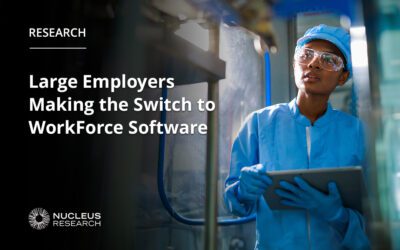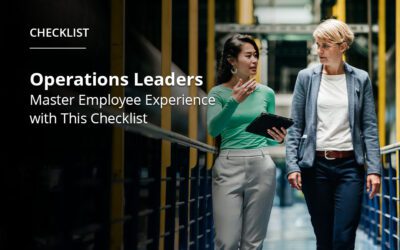Scheduling Re-Imagined: Work Smarter, Not Harder | Part 4
If You’re Ready to Re-Imagine Employee Scheduling, Be Sure to Ask These Tough Questions


Denise Broady
COO, WorkForce Software
In the previous installment of this 4-part journey to reimagine scheduling, we took a more in-depth view of the most common scheduling methodologies and laid out the benefits of each. If you are like most organizations, you likely discovered you need a combination of two or more approaches. This is especially true for multi-faceted organizations that span across multiple industries and/or geographical regions. You will want to avoid settling for disparate systems or gaps in functionality that require error-prone manual workarounds when selecting a vendor. That is why I am sharing these 5 tough questions you need to ask any prospective vendor to determine whether they are a true partner in your success or just another vendor.
Question 1: How are you incorporating emerging technology and trends in your solution to support innovation and maintain a leading position in the market?
A great example of this is artificial intelligence (AI). Nearly every vendor out there is talking about AI, but to what extent have they put it into practice? Are they taking a reactive or proactive approach? Are scenarios pre-programmed, or is there a machine learning element to their execution?
For example, a machine learning approach to labor forecasting can look at historical patterns and trends, apply its learnings to the current environment, and project the impact on staffing levels accordingly. As the time approaches and new data is received, it can reforecast demand and provide insights into potential adjustments in staffing levels for even more precise alignment with business KPIs.
Question 2: In a period of disruption or opportunity, how will your solution help us quickly adapt so that we can keep operations running smoothly?
The COVID-19 pandemic is an example of disruption at an epic proportion that has proven that we need to be prepared for the unexpected. Organizations without access to modern and innovative technology were (and still are) scrambling to catch up—resulting in sharper declines in revenue, higher operational costs, and higher volumes of layoffs and furloughs. An automated scheduling solution that incorporates machine learning labor forecasting would have likely helped these organizations to swiftly adapt to this “new normal.”
Of course, the unexpected comes in many forms—from uncertainties to new opportunities for growth. For example, a utilities company in storm mode may need a solution to tap into their entire workforce to identify individuals that are best suited to fill temporary gaps in coverage in order to expedite the restoration of power—including asking employees to perform duties outside of their normal responsibilities. A manufacturer solely focused on producing goods may realize it is the time to launch retail operations to sell their goods direct. A solution that is purpose-built for manufacturing most likely would not be the right fit for their retail operations.
Question 3: Can you provide examples of where you have introduced innovations that improve the employee experience as well as help employees successfully balance their personal and professional lives?
Employee engagement continues to allude many organizations, but they continue to look for ways to move the needle in the right direction and provide employees with tools that enrich their work experience, including implementation of fair and predictive scheduling practices, flexible working arrangements, career development planning, and much more. A robust scheduling solution can enhance these efforts and even take on some of the heavy lifting.
For example, employees in highly variable work environments don’t always have the luxury of a consistent schedule. An automated scheduling solution that incorporates machine learning labor forecasting publishes optimized schedules well in advance and can provide employees with the necessary breathing room they need to arrange for childcare, appointments, or the pursuit of personal enrichment activities. When conflicts do arise, rules-driven shift swapping can ease administrative burden by presenting only those shifts where constraints are enforced, such as the right qualifications, neutral cost considerations, work hour limits, and sufficient rest periods.
Flexible work arrangements can be great a benefit for attracting and retaining top talent, but employers fear that productivity or coverage could suffer. A solution that sets the right expectations upfront by establishing core working hours—to ensure proper coverage—along with boundaries when working hours can flex goes a long way. The solution should also add controls to support enforcement with alerts when core hours are approaching or if there is risk that required work hours will exceed the boundaries.
For career progression planning, look for features that enforce qualifications and support a sliding scale for proficiency to support pairing of top performers with those less experienced to support knowledge transfer and mentorship while preventing a performance impact during peak business periods.
6 Essential Workforce Management Strategies for a Safe and Productive Return to Work
Download this eBook to learn 6 essential workforce management strategies that will help you design a safe and structured return-to-work plan.
Question 4: How does your solution simplify and prove compliance with legislative and contractual rules?
When it comes to safeguarding employee rights, prevention is key. Damage control is costly after the fact and can result in litigation, fines, penalties, and ultimately, damage to your brand damage. You want a solution that enforces constraints driven by legislation, employment agreements, and industry standards, such as work hour limits, breaks, rest periods, and minimum qualifications during the scheduling process, but this won’t completely eliminate the risks. The right solution will be able to evaluate actual hours against planned hours and proactively warn you of the potential issue so you can address it before it occurs. For example, if an employee works past their scheduled hours, you would want an alert to let you know if the employee is approaching a situation where they would not receive a sufficient rest period so you could ask them to end their current shift or adjust their next shift.
Earlier, we talked about fair and predictive scheduling practices, but I failed to mention that there are employment agreements as well as region-specific legislation that dictate notification periods for publishing schedules and schedule changes. Notification compliance is just one more incremental benefit of incorporating machine learning labor forecasting into your automated scheduling process.
Question 5: How does your solution empower our leadership to make strategic business decisions?
Data drives decisions and access to the right data across all your critical systems can provide valuable insights into your workforce. For example, a solution that accepts critical business driver data from third-party systems can create accurate labor forecasts weeks and even months in advance. This allows you to generate and populate schedules and identify any potential talent shortages or surpluses. This could trigger a ramp up in recruiting efforts or give leaders time to build a strategy on how idle workers can be leveraged on special projects or other activities. Conversely, giving a data warehouse or a data visualization or Business Intelligence tool access to your forecasts and scheduling data will allow you to correlate this data with other significant data sources for more strategic reporting and analysis.
Are You Ready to Re-Imagine Employee Scheduling?
Asking the right questions is the first step to finding the right solution for the complex enterprise with multi-faceted requirements. Be sure to account for your needs today and your aspirations for tomorrow with open-ended questions that invite prospective vendors to demonstrate the value they bring to the table, or you may find yourself forced into a box without valuable insights into the efficiency, productivity, and engagement of your workforce that can empower your organization to work smarter, not harder.
Learn how the WorkForce Suite’s Scheduling capabilities can be a game-changer for your organizations.
Subscribe to The WorkForce Blog
Learn the art and science of maintaining productive, happy, engaged employees.
Discover More
Nucleus Insights from WorkForce Customers Research Note
Nucleus Research interviews WorkForce customers who validate why we’re ranked the #1 WFM enterprise vendor for 10 consecutive years.
Elevate Employee Experience: Checklist for Operational Leaders
Get the practical steps and technology functionalities operation leaders need to improve their employees’ work experiences.
Streamlining Complex Workforce Compliance Requirements Boosts Productivity
Discover how workforce compliance software helps EMEA organisations navigate complex legislation, enhance compliance and boost operational efficiency.




